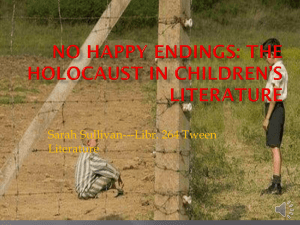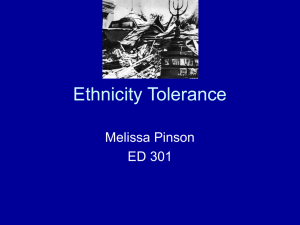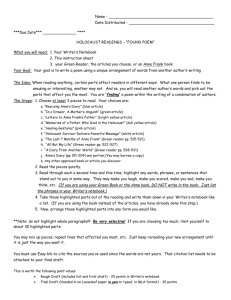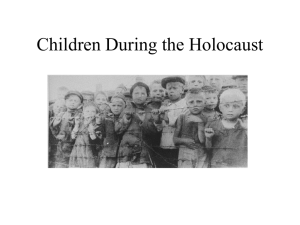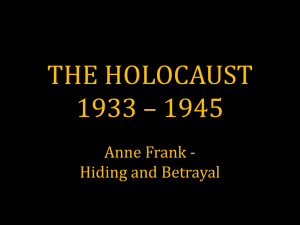Holocaust Unit launch
advertisement
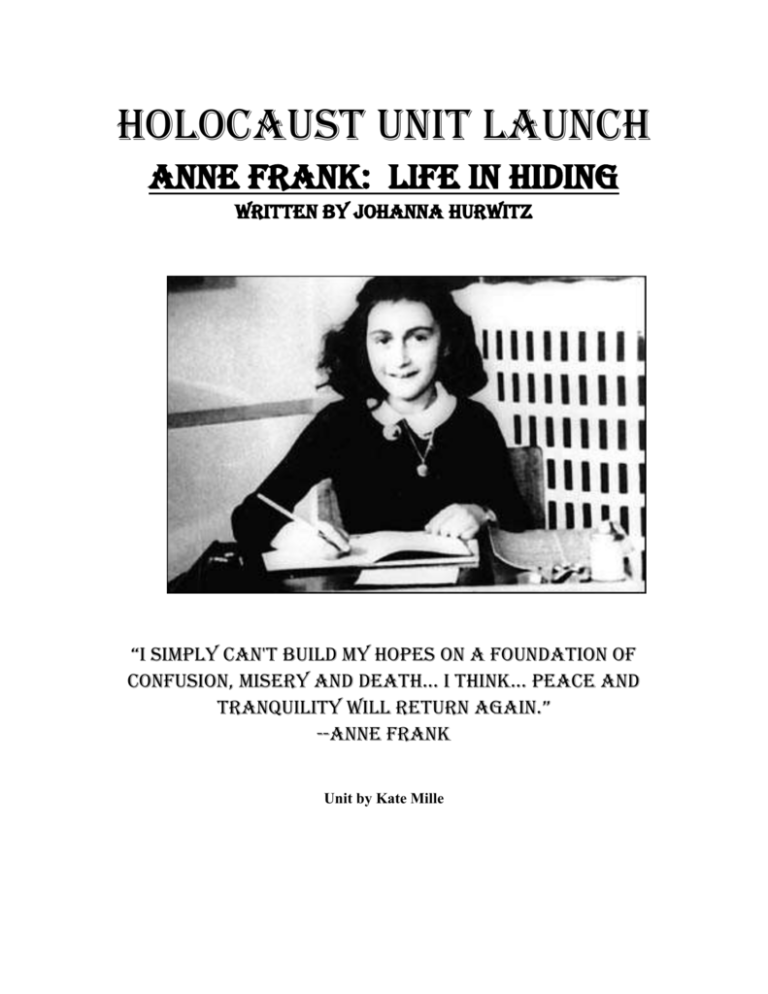
Holocaust Unit launch Anne Frank: life in hiding Written by Johanna Hurwitz “I simply can't build my hopes on a foundation of confusion, misery and death... I think... peace and tranquility will return again.” --Anne Frank Unit by Kate Mille Text References Hurwitz, Johanna. Anne Frank: Life in Hiding. The Jewish Publication Society: New York, 1988. ISBN 0380732548 Vos, Ida. The Key is Lost. Harper Collins Publishers: New York, 1996. ISBN 0688162835 When I first began thinking about a topic for my multi-text unit, I knew that I wanted to put together something pertaining to Holland because I have many ties to this great country. My father is one hundred percent Dutch and I have a lot of family that still lives in Holland. Since being in college, I have had the opportunity to visit the country and get to know my extended family that lives there. This has been an amazing experience for me that has helped me to become the person that I am today. The country of Holland has many ties to the Holocaust because many Jewish people fled there to escape the persecution they were facing during the 1930’s and 1940’s in Europe. Even though the events of the Holocaust occurred in Europe, it was a very influential time all around the world, especially in the United States. The Holocaust is a topic that is commonly studied and discussed in sixth grade, which lead me to choose this as my topic for the multi text unit. I chose the book Anne Frank: Life In Hiding by Johanna Hurwitz as the book to launch the unit because it is a biographical account from a child’s point of view of what it was like to be a Jew during the Holocaust. Although this is a biography, there are still a lot of primary sources embedded throughout the text. For example, there are several pictures in the book that show students what life was like for Anne. There are also countless excerpts from Anne Frank’s famous diary that allow children to feel as though they are experiencing everything that Anne experienced first hand. This book in general encourages the reader to use their senses so he or she can fully feel present in the things that Anne experienced during the Holocaust. The book that I chose as the main text novel was The Key is Lost by Ida Vos. I thought this book would be a good paring with Anne Frank: Life in Hiding because it is about a Jewish family that was forced to go into hiding in Holland. This book depicted the struggle that many Jewish families had to face during the Holocaust. Throughout the book the family is forced to move from place to place in order to keep from being caught by the Nazis. I think this is a good book to use with this age group because it depicts the constant trouble and terrible time of the Holocaust, but also shows the compassion that many non Jewish people showed towards the Jews. Both of these texts are written on a fifth grade level, but were factored in to be used during a sixth grade unit on the Holocaust. Even though these texts were not exactly on track with the reading level of the grade, I still chose them as the main texts for the unit. The Holocaust is a very heavy topic for elementary children to face and I felt as though both of these texts would provide the students with truth on the topic. Anne Frank: Life in Hiding shows a predominantly negative view of the Holocaust from a young Jewish girl’s prospective. The book vividly paints a picture of what it was really like to be a Jew during this time period which is imperative for the children to experience. The Key is Lost also shows this side of the Holocaust but also discusses and shows the compassion that many non-Jewish people had towards this cultural group. Also, the main characters in both of these texts are around the same age as a sixth grade student. Therefore, the students will feel as thought they can relate to the characters and their experiences more so then the students would be able to relate to the information in a social studies text book. Additional Unit Books Verhoeven, Rian. Anne Frank: Beyond the Diary. Scholastic Inc.: New York, 1992. ISBN 0590474472 This book was created for the Anne Frank House and is a photographic remembrance of Anne Frank. This book is full of pictures of Anne Frank and her family, but also showcases pictures of what it was like to be Jewish during the time of the Holocaust. This book directly relates to the informational text and could be used to show the students further what life was like for Anne Frank through pictures rather than text. Written by David A. Adler; Illustrated by Karen Ritz. A Picture Book of Anne Fank. Holiday House: New York, 1993. ISBN 082341003X This is another book that traces the life of Anne Frank through pictures. This book directly relates to the informational text and could be used to show the students further what life was like for Anne Frank through pictures rather than text. Hintz, Martin. The Netherlands. Children’s Press: New York, 1999. ISBN 0516209620 This book is an informational text about the Netherlands that includes information about the country. This book is a good resource to use with the main novel text of the unit because the family in the book is force to move all over Holland to escape the Nazis. The students could use this text to become more familiar with the country. Netherland Travel Map. New Holland Publishers: UK, February 2002. ISBN 1859745865 This reference tool is a map of Holland. This directly relates to the main text novel because the family in the book is forced to move all over Holland in order to escape the Nazis. Students could use this map to chart the journey of the family. Written by David A. Adler; Illustrated by Karen Ritz. Hiding From the Nazis. Holiday House: New York, 1997. ISBN 0823412881 This book is about a young Jewish boy who was placed with a Christian family in Holland to avoid being persecuted by the Nazis. This book relates to both the informational text and the main text novel because it is about a child who was forced to hide from the Nazis during the Holocaust. Students could use this book to get a “male perspective” of what things were like during this time period. Lowry, Lois. Number the Stars. Houghton Mifflin Company: Boston, 1989. ISBN 0395510600 This book is about a family who helps shelter Jewish people during the Holocaust. This book relates to the main text novel because it shows what it was like to be one of the families that helped to keep the Jews safe during this time in history. Bachrach, Susan D. Tell Them We Remember: The Story of the Holocaust. Little Brown Company: New York, 1994. ISBN 0316692646 This book gives an account of what the Holocaust was like all around Europe using pictures and other primary data as well as text. This book directly relates with the main text novel because it puts visuals with the story of the Holocaust. Ray, David. One Thousand Years and Other Poems about the Holocaust. Timberland Press: MO, 2003. ISBN 0944048307 This book is an anthology of varies forms of poetry written about the Holocaust. This book relates to the main text novel because it pertains to the topic of the Holocaust. This book allows students to read about and experience the Holocaust in a different form. All of these additional unit books would help to expand a student’s knowledge and understanding of the Holocaust. Allowing students the opportunity to self select books from this additional resources list ensures that they will gain new knowledge on the topic. When children are allowed to make their own controlled choice about what they read, they become more interested in reading and learning more about the topic at hand. All of these book include expanded information that pertains to both the informational text Anne Frank: Life In Hiding and the main text novel The Key is Lost. In fact these additional books include new and different information about the Holocaust that cannot be found in either of the main text books. Therefore, by reading one or more of the books on this additional unit books list, students will have a better understanding of the culture on which this unit is based on. Holocaust Unit launch Anne Frank: life in hiding Written by Johanna Hurwitz “I simply can't build my hopes on a foundation of confusion, misery and death... I think... peace and tranquility will return again.” --Anne Frank Name:______________________________ Student Packet Anne Frank: Life In Hiding is a biography about Anne Frank. Many of you have probably heard about Anne Frank before and her contribution in the Holocaust. To begin the launch to this unit you will first complete the chart below. Things I Know about Anne Frank As we read Anne Frank: Life In Hiding, you will keep a log of things you learn about the Holocaust through Anne Frank’s experiences. This will be important because it will help prepare you to read The Key is Lost by Ida Vos, so be sure to take good notes! Holocaust Notes *You may continue on another page if necessary.* As you read Anne Frank: Life In Hiding, you will complete three journal entries in your Holocaust Journal. In the first journal entry, you will pretend that you are Anne Frank and writing a letter to a friend. This friend can be either Jewish or non Jewish, a child or an adult. You can write the letter before you go into hiding, when you first go into hiding, or towards the end of hiding. Be sure to tell whoever you are writing to what you are experiencing and how you feel. Be creative and try to sound as “Anne-like” as possible! In the second journal entry, you will pretend as though you are a child that was alive during the Holocaust. You will write a letter to Adolph Hitler and/or the Nazi troops explaining your position on the Holocaust. Be sure to go into detail about your position using examples we have learned in class and through Anne Frank’s biography. The final journal entry is your choice. You may write about anything you want as long as it pertains to Anne Frank or the Holocaust. These journal entries will be due after we finish reading together Anne Frank: Life In Hiding and before we start reading together The Key is Lost, so do not wait until the last minute! The Key is Lost by Ida Vos This is a drawing by Dudkova Kamila, and 11 year old from the Czech Republic. The drawing was submitted to an exhibit entitled “The Holocaust Through Czech Children’s Eyes in 2003. “The Holocaust is a horror we must remember, but not only because of the dead; it is too late for them. Not only because of the survivors; it may even be too late for them. Preserving memory is a solemn responsibility, aimed at saving men and women from apathy toward evil, if not from evil itself. We must never forget.” —William J. Jefferson Name _____________ Before You Read: Look carefully at the front cover of the book. Write down your predictions about the following: Setting (Time and Place) When and Where do you think this book takes place? Why, what makes you think this? ________________________________________________ ________________________________________________ ________________________________________________ Characters (The people, animals, or objects around which the action of the story is centered) Who do you believe the main characters in the book will be?____________________ ________________________________________________ Problem(s) & Solution(s) (What goes wrong in the story and how it is solved) What do you predict will be the most significant problems in this book? How do believe the problems may be solved? __________________________ ______________________________________________ ______________________________________________ Write down any other questions or predictions.___________ _______________________________________________ Book Choose 1 or 2 items from the chart below to create pages for an alphabet book for all to share. Each page should include a large capital letter, an illustration or some artistic impression, and a paragraph (at least 5 sentences) explaining your letter representation. Design your page with an interesting format and type font. Your page should be vertical. The following are examples you may use but are not limited to: A Mr. Ami, Adolph Hitler, Attic B Boring C D Concentration Dangerous, Camp or Dark Cubbyhole E Eva F Family or Freekie G Germans or Geesje L Lisa H Holocaust, Hiding, I Imagination J M Marie-Jeanne or MarieLouise Dutour, Mama N Nazis, Netherlands O R Rules, Regulations S Separation, Secrets, Strangers T Train, Travel K Kind Strangers, Knitting P Pretend, Puppet, Papa Q Quiet Jews Outside U Uncle Samuel V Visitors W Work Camps, War X eXtreme Y Yellow Star Z The Zilverstijns Character Sketcher Your job as Character Sketcher is to identify a character’s actions (traits) and explain or prove these traits, identify the character’s goal (which is what the character wants to do or accomplish), identify the problem and solution in the reading, and complete a sketch or illustration of the character. You need to be aware that the character traits you will choose will be implied character traits. In other words, they are not directly stated in the passage. You really want to use descriptive words for your character traits. You do not want to use words like good, bad, nice, and mean. Be sure to use your “Descriptive Character Traits” page for help. Sometimes the solution to your character’s problem will not be in the section of the book that you are reading. In this case, you will need to come up with a possible solution for your character’s problem. When you begin artistically representing your character, try to use any physical descriptions from the text to help you. Your “artistic impression” of the character will probably be on a separate piece of paper. The next page gives you an example of how your paper may look with the character information. Character’s Name_____________________________ Section and title of the book you are reading: __________________________________ Implied Character Traits (3) 1. (trait)____________ p. __ par. ___ (explanation or proof of trait) 2. (trait)____________p. __par.____ (explanation or proof of trait) 3. (trait)___________p. ___par.____ (explanation or proof of trait) Character Goal: _____________’s goal is to ________________________________________________________________. Problem : ____________’s problem is ________________________________________________________________. Solution or Possible Solution:_________________________________________ Discussion Director The Key is Lost Your job is to involve the students in your group by thinking and talking about the section of the book you have just read. You are going to ask questions that really help the students in your group think about the reading. Your questions should require students to discuss their interpretations of the text and connect background experience and knowledge with the text. You want all students involved in the discussion and talking about issues that come up during the reading. Your job as the Discussion Director is to come up with 5 thinking questions. Your teacher really wants you to help the students in your group to go back to the book to find their answers if they don’t know them. So, to help this run very smoothly, you need to write down the questions, your answers to your questions, and the page numbers where the students can reference the text to justify their responses to your questions. When developing your questions, think about Eva and Lisa’s experiences with all the different places they were forced to go into hiding to escape the Nazis. Think about all the people that helped them and their family. How were some places different than others and how were they similar? Vocabulary You will complete the following chart with child-friendly definitions for these words. Then, you are invited to complete a set of daily vocabulary activities to go with these words. Word Huguenots p. 8 pantomiming p. 9 Nazis p. 11 procession p. 23 contagious p. 116 tranquilizers p. 182 authority p. 192 satisfaction p. 195 Meaning 1. Word Networks What people, things, situations, or words come to mind when you think about the word Huguenots? Huguenots Repeat for all words on Vocabulary page locate above. 2. Synonyms and Antonyms Synonym Word Antonym Huguenots pantomiming Nazis Repeat for all words located on vocabulary sheet 3. Sentence Stems/Idea Completions My friend refused to give me the satisfaction of knowing that I was right because _____________________________________________ ________________________________________________________. Eva and Lisa did not like the Nazis because _____________________ __________________________________________________________________. Repeat for all words located on vocabulary sheet. You are invited to complete a Double-Entry Diary for the first third of the book (pages 7-85). Remember to write down the quotation or passage and the page number on the left side of your paper. On the right side of your paper, write your response or personal reactions and connections to what was written in the left column. Quotation/Passage and page number Your response, reactions, and connections to the quotation or passage. You are invited to complete a Double-Entry Diary for the second third of the book (pages 86-178). Remember to write down the quotation or passage and the page number on the left side of your paper. On the right side of your paper, write your response or personal reactions and connections to what was written in the left column. Quotation/Passage and page number Your response, reactions, and connections to the quotation or passage. You are invited to complete a Double-Entry Diary for the last third of the book (pages 179-268). Remember to write down the quotation or passage and the page number on the left side of your paper. On the right side of your paper, write your response or personal reactions and connections to what was written in the left column. Quotation/Passage and page number Your response, reactions, and connections to the quotation or passage. Internet Workshop for The Key is Lost This internet workshop will introduce you the Holocaust that occurred all over Europe during the 1930’s and 1940’s. You will have an opportunity to explore information on the Internet. Take notes in your Internet Journal. Come prepared to share your information at our workshop session. We will discuss possible ways of presenting your information (Inspirations, PowerPoint, Poster, Graphic Organizer, What Am I Poem, Who Am I Poem, or I Poem). http://www.graphic.org/index.html. Please complete the following workshop. See rubric for presentation information: Read about Adolph Hitler and his role as the leader of Germany. Read Hitler Comes to Power by clicking on http://www.ushmm.org/outreach/power.htm then read The Nazi Terror Begins by clicking on http://www.ushmm.org/outreach/terror.htm. When you have finished reading The Nazi Terror Begins, click on the Nazi Rule tab at the top of the page to read more in depth about the Nazis. These pages will help you gather more information about what kind of leader Hitler was and the kind of armed service the Nazis were. After you have read these pages, take a few minutes to answer the following questions in your Internet Journal. Who was Adolph Hitler? What kind of leader was he? Why was he important to the Holocaust? Who were the Nazis? What was their role in the Holocaust? Do Adolph Hitler and the Nazis sound like leaders you would want to be held in charge of your country? Why or why not? Now that you know a little bit more about Adolph Hitler, Germany during this time period, and the Nazis, let’s take a look at why and how the Jewish population in Europe was targeted during the Holocaust. To gain more background knowledge, read Jews in Prewar Germany, 1933 by clicking on http://www.ushmm.org/outreach/jger33.htm. Then click on the Nuremberg Laws tab at the top of the page and read it to find out what classified a Jew to the Nazis. Click on the following link http://www.ushmm.org/outreach/fsol.htm to read about what the Nazis “plan” was concerning the Jews in Europe. Ghettos and concentration camps were typical tools used by the Nazi government to get rid of the Jews in Europe. First, click on http://www.ushmm.org/outreach/ghettos.htm and http://www.ushmm.org/outreach/lghetto.htm to read what it was life was like for Jewish people send to the Ghettos all around Europe. Then click on http://www.ushmm.org/outreach/ncamp.htm to see what life was like for Jewish people sent to the concentration camps around Europe. After you have read these pages, take a few minutes to answer the following questions in your Internet Journal. What classified someone as being Jewish during the Holocaust? Do you think this is fair? Why or why not? What was life like in the Jewish Ghettos? What was life like in the concentration camps? EXTRA! EXTRA! READ ALL ABOUT IT! The Holocaust is finally over and you are invited to write a feature story (using Microsoft Publisher) recounting Eva and Lisa Zilverstijn’s struggle to stay hidden and alive during the Holocaust in Holland. Think of a name for your newspaper For common newspaper names see the following: http://en.wikipedia.org/wiki/List_of_common_ne wspaper_names Write an interesting title for your feature story Describe Lisa and Eva’s struggle, who helped them along the way, etc. When writing a feature story remember: The main purposes of a feature lead are to set the tone and grab the reader's attention- to draw the reader in— to make him or her curious. A chronological or narrative pattern of organization is used. The final paragraph should complete the story. The best ways to do this are to refer back to the lead or use a quote to refer to the future. The story should reflect the subject's character and personality. Feature stories should contain direct quotes. Write creatively, use color and imagination, and cause people to come ALIVE with your writing. Throughout the book, Eva and Lisa had to constantly move from place to place. At first, the girl’s mother and father were there with them through every move; but as time went on, the family was not able to stay together. There were many points in the book where Eva and Lisa felt that they could not go on any further. We know that the girls did not give up and made it through the Holocaust alive. Why do you think the girls were able to persevere and what do you think kept them going? Has there ever been a time in your life that you felt that all you could do was give up? Describe a time like this and also include how you were able to get through the difficult time. Author’s Craft Ida Vos chooses her words very carefully, making use of several interesting literary devices. She targets the reader’s senses so the reader can feel as though he or she is experiencing everything right along with Eva and Lisa because the events in the book are based on events that Ida Vos actually experienced during the Holocaust. Because of this, the book is full of figurative language. Find two examples of each listed below. Then explain how each passage adds meaning to the story. Hyperbole: extreme exaggeration page 18: Eva is nearly drowning in the huge leather chair. simile: a comparison that includes the words like or as page 23: Compared to Geesje’s shoes, Ali’s shoes looked like boats. Page number/ Page number/ Example/ Example/ What does this passage add to the story? What does this passage add to the story? Now that you have chosen two examples of similes, please artistically represent one of these comparisons. You may use any artistic medium. The following are options: colored pencils, watercolors, pastels, collage, etc. Enjoy! Rubric Activity/Criteria Pre-Reading Activity All questions are answered completely with complete sentences. All questions are justified when necessary Your points/Total possible points 5 points Page for Alphabet Book Information is correct and interesting Information is organized Design is creative and inviting Directions are followed 20 points Character Sketcher Sketch includes thoughtfully selected information about the character, including 3 implied character traits, problem and solution, and character goal Artistic Impression is creative and demonstrates knowledge of information given in text regarding character’s physical description 20 points Discussion Director Questions displays insights into novel’s main events and themes; questions are “higher-level” Answers are provided and when appropriate, page #’s 20 points Vocabulary Definitions and Activities Definitions are “child-friendly” Activities are correct and complete 25 points Double-Entry Diary Example is well chosen, well explained and thoughtfully crafted Provides more than one thoughtful idea/supporting reason 15 points Internet Workshop (1 workshop complete) Notes reveal thoughtful preparation for participation Information in graphic organizer, PowerPoint or poem is correct and well organized; main ideas are present Visual representation is present and of high quality 50 points Feature Story Interesting lead grabs the reader Concise, organized, and creative story which includes necessary details and reveals understanding of main character’s personality Specific examples in text are referenced Word choice is thoughtful and demonstrates an understanding of the historic nature of the events as well as free from grammar and spelling errors 25 points Author’s Craft Chart includes 2 well-chosen examples of simile and hyperbole from the novel Explanations are included of how figurative language adds meaning to the text Artistic representation is thoughtful and creative 20 points North Carolina Language Arts Standard Course of Study Correlations Grade 6 UNIT ACTIVITY NC LANGUAGE ARTS GRADE 6 Students will develop journal entries during 1.01 Narrate an expressive account (e.g., the Holocaust unit launch. In the first fictional or autobiographical) which: journal entry, the students will pretend that they are Anne Frank and write a letter to a uses a coherent organizing structure friend. In the second journal entry, the appropriate to purpose, audience, students will write a letter to Adolph Hitler and context. and/or the Nazi troops explaining his or her tells a story or establishes the stance on the Holocaust. significance of an event or events. uses remembered feelings and specific details. uses a range of appropriate strategies (e.g., dialogue, suspense, movement, gestures, expressions). The students will participate in an internet workshop that pertains to one of the main themes in The Key is Lost. The students will learn more about the Holocaust by investigating Adolph Hitler and the Nazi Troops and by also finding out more information about what it was like to be Jewish during this time period on Europe. 2.01 Explore informational materials that are read, heard, and/or viewed by: Students will develop a feature story. The main idea of the student’s feature article will be the end of the Holocaust. The student’s articles will sum up all of the experiences that the main characters in the Key is Lost were forced to face during their struggle to stay alive during this time period on Holland. monitoring comprehension for understanding of what is read, heard and/or viewed. studying the characteristics of informational works. restating and summarizing information. drawing inferences and/or conclusions. generating questions. 2.02 Use multiple sources of print and nonprint information in designing and developing informational materials (such as brochures, newsletters, and infomercials) through: exploring a variety of sources from which information may be attained (e.g., books, Internet, electronic databases, CD-ROM). distinguishing between primary and secondary sources. analyzing the effects of the presentation and/or the accuracy of information. The students will participate in two activities were they will delve into the Ida Vos’ craft in The Key is Lost. The students will look at the author’s craft of figurative language throughout the text. 4.01 Determine the purpose of the author or creator by: analyzing the effects of author's craft on the reader/viewer/listener. Context I created this multi-text study in RE 4030 under the advisement of Dr. Woodrow Trathen in the fall of 2005 as a Block II requirement. The study is geared toward the sixth grade and was created around the fiction and non-fiction books entitled The Key is Lost and Anne Frank Life in Hiding. In addition an Internet Workshop focusing on the Holocaust was created to promote a better understanding of the main focuses of the two main texts. This unit is a language arts unit which integrates social studies content areas. The references for my unit are as follows: The Key is Lost by Ida Vos Anne Frank: Life In Hiding by Johanna Hurwitz http://www.ushmm.org/outreach/power.htm http://www.ushmm.org/outreach/terror.htm http://www.ushmm.org/outreach/jger33.htm http://www.ushmm.org/outreach/fsol.htm http://www.ushmm.org/outreach/ghettos.htm http://www.ushmm.org/outreach/lghetto.htm http://www.ushmm.org/outreach/ncamp.htm Impact This multi-text study is a great way to integrate both fiction and non-fiction texts through very creative and engaging formats. Through reading both fiction and nonfiction text, students are given the opportunity to think critically about what they read while completing a variety of engaging language arts activities that connect to the multi-texts. I chose to develop this unit because The Holocaust is an important time period of Europe, the United States, and the world that still very influencial today. Since I did not have a chance to implement my multi-text study this semester, I hope to put the unit to use in my student teaching and future classroom in order to engage the interests and intellects of my students. Alignment This multi-text study unit aligns with the Department of Public Instruction standard 1, indicator 3. In this study, I have included not only a fictional text, but I have also included non-fictional texts which addresses diversity through introducing students to the Holocaust. This unit also aligns with the Department of Public Instruction standard 1, indicator 4. This indicator is met through addressing the needs of students by providing a variety of instructional activities in which students are able to exercise their communication skills through a multitude of reading, writing, listening, and speaking activities that cater to a multitude of learning styles. This study aligns with standard 1, indicator 5. Throughout the multi-text study, I ask students questions in order to activate prior knowledge that they have about the books they are reading. Students are provided with individual and small group activities in which they are able to interact with the text in order to increase their reading and comprehension skills. This lesson also meets standard 1, indicator 6. As a teacher, it is my job to encourage the development of literacy in each of my students. It is also my job to cater to the individual needs of the students in my class by providing developmentally appropriate activities that will help and not hinder the development of literacy. Standard 7, indicator 2 is met through integrating language arts, social studies and technology into this unit. Students are reading, writing, learning about the what life was like during the Holocaust for both Jewish and non Jewish people, and participating in an internet workshop. Standard 7, indicator 3 is met by activating the prior knowledge of students through having them make predictions about their reading. Standard 7, indicator 5 is met by providing the students with activities that cater to a variety of different learning styles. As a part of this study, students will be artistically representing similes, participating in a character sketcher activity, working in small groups in a discussion director activity, writing poems, and even creating a wanted poster for one of the characters in (example: Tuck Everlasting). Standard 7, indicator 7 is met by assessing students both informally and formally through observations and a written vocabulary assessment at the end of the vocabulary activities section of the multi-text study. Standard 8, indicator 3 is met by encouraging students to use critical thinking skills when reading or writing through the use of positive feedback and guidance. Standard 8, indicator 4 is met through providing students with exciting and interesting literature such as the novel The Key is Lost and the informational text Anne Frank: Life In Hiding. Standard 8, indicator 5 is met by providing students with a variety of different writing activities such as writing an “I am” poem, creating a wanted poster, writing entries in a double-entry diary, and creating an ABC book. Students are encouraged to share their products in both small and large group settings. Standard 8, indicator 6 is met by making sure that I, as the teacher, use proper English when working with students so that I will serve as a good model for them as they continue to develop their use of the English language.
